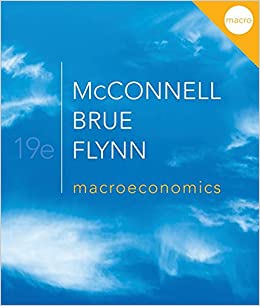
Macroeconomics 19th Edition by Campbell McConnell , Stanley Brue,Sean Flynn
Edition 19ISBN: 978-0077337728
Macroeconomics 19th Edition by Campbell McConnell , Stanley Brue,Sean Flynn
Edition 19ISBN: 978-0077337728 Exercise 1
Demand and supply often shift in the retail market for gasoline. Here are two demand curves and two supply curves for gallons of gasoline in the month of May in a small town in Maine. Some of the data is missing. 
a. Use the following facts to fill in the missing data in the table. If demand is D 1 and Supply is S1, the equilibrium quantity is 7000 gallons per month. When demand is D 2 and supply is S1, the equilibrium price is $3.00 per gallon. When demand is D 2 and supply is S1, there is an excess demand of 4000 gallons per month at a price of $1.00 per gallon. If demand is D 1 and supply is S2, the equilibrium quantity is 8000 gallons per month.
b. Compare two equilibriums. In the first, demand is D 1 and supply is S1. In the second, demand is D 1 and supply is S2. By how much does the equilibrium quantity change? By how much does the equilibrium price change?
c. If supply falls from S2 to S1 while demand declines from D 2 to D 1, does the equilibrium price rise or fall or stay the same? What if only supply falls? What if only demand falls?
d. Suppose that supply is fixed at S1 and that demand starts at D 1. By how many gallons per month would demand have to increase at each price level such that the equilibrium price per gallon would be $3.00? $4.00?

a. Use the following facts to fill in the missing data in the table. If demand is D 1 and Supply is S1, the equilibrium quantity is 7000 gallons per month. When demand is D 2 and supply is S1, the equilibrium price is $3.00 per gallon. When demand is D 2 and supply is S1, there is an excess demand of 4000 gallons per month at a price of $1.00 per gallon. If demand is D 1 and supply is S2, the equilibrium quantity is 8000 gallons per month.
b. Compare two equilibriums. In the first, demand is D 1 and supply is S1. In the second, demand is D 1 and supply is S2. By how much does the equilibrium quantity change? By how much does the equilibrium price change?
c. If supply falls from S2 to S1 while demand declines from D 2 to D 1, does the equilibrium price rise or fall or stay the same? What if only supply falls? What if only demand falls?
d. Suppose that supply is fixed at S1 and that demand starts at D 1. By how many gallons per month would demand have to increase at each price level such that the equilibrium price per gallon would be $3.00? $4.00?
Explanation
a. The table below shows the correspondi...
Macroeconomics 19th Edition by Campbell McConnell , Stanley Brue,Sean Flynn
Why don’t you like this exercise?
Other Minimum 8 character and maximum 255 character
Character 255


